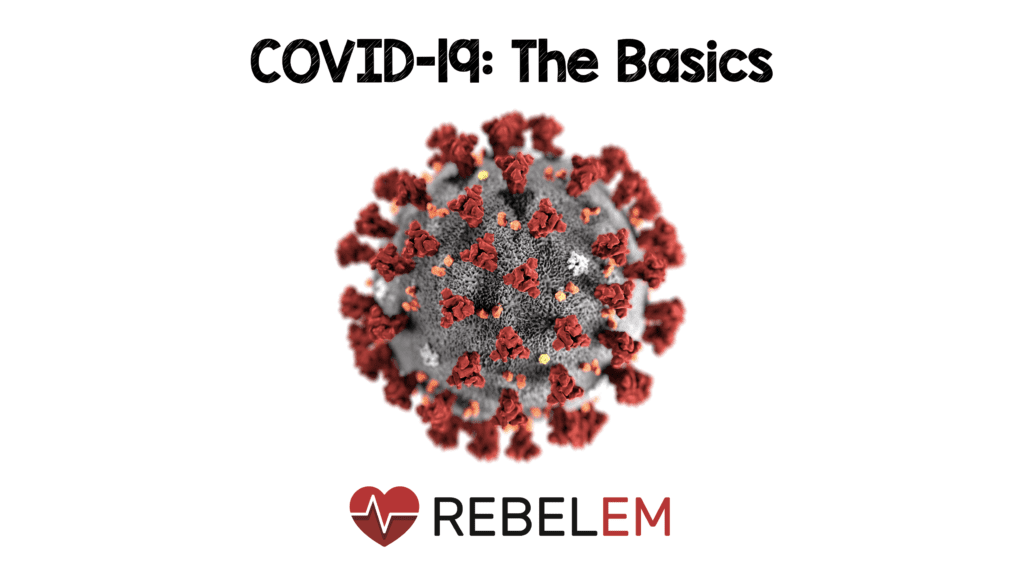

To go back to the main post, click on the image below…

COVID-19 Compared to SARS, MERS, and Influenza [1][3][4]
- Severe Acute Respiratory Syndrome – SARS-CoV (2002 – 2004)
- 8,096 cases and 744 deaths (Case fatality rate 9.2%)
- Middle Eastern Respiratory Syndrome – MERS-CoV (2012 to 2016)
- 2,494 cases and 858 deaths (Case fatality rate 34.4%)
- COVID-19 (Dec 2019 to Present)
- As of May 4th, 2020, 3,571,615 cases and 250,134 deaths (Case fatality rate 7.0%) –> Updated Daily Stats from Johns Hopkins CSSE
- The case fatality rate of COVID-19 is likely overinflated (As testing becomes more available and includes asymptomatic and mild cases, more realistic numbers will be available – i.e. as the exact denominator is unknown, it is unclear what the true rates of death are)
- In one study [2], of 138 hospitalized patients with confirmed novel coronavirus-infected pneumonia (NCIP), the rate of hospital-associated transmission was:
- Active Health Care Professionals: 40 (29%)
- Hospitalized Patients: 17 (12.0%)
- This suggests a 41% nosocomial spread
- Influenza (Sept 2019 Up to Week Ending Feb 15th, 2020)
-
- 29,000,000 cases 280,000 hospitalizations, with 16,000 flu related deaths (Case fatality rate 0.06%)
-
- As of May 4th, 2020, 3,571,615 cases and 250,134 deaths (Case fatality rate 7.0%) –> Updated Daily Stats from Johns Hopkins CSSE
How Contagious is the Disease? = R0 (R nought)
- R0 = One case of the disease will potentially spread to how many others
- Below is a list of approximate R0 for various infections (These numbers can vary depending on which study you read, but give an idea of how transmissible different illnesses can be):
- Measles = 12 – 18
- Smallpox = 5 – 7
- SARS = 2 – 5
- Pandemic Flu = 2 – 4
- COVID-19 = 2.2 – 3.9
- Seasonal Flu = 0.9 – 2.1
- MERS = 0.3 – 0.8
The Diamond Princess Cruise Ship [7]
- Although, unfortunate, the Diamond Princess cruise ship gave us great insight into what the spread of COVID-19 looks like in an isolated environment
- 3711 people on board with 355 cases confirmed (As of Feb 16th, 2020). This gives an R0 of 2.28 for COVID-19
- Deaths from COVID-19 was 7 out of 355 cases (Case Fatality Rate of 1.9%)
Signs and Symptoms of COVID-19
- Incubation period is 2 – 14 days (Median 5 to 6 days)
- Most common symptoms [5][6]:
- Fever (83 – 98%)
- Of 1099 pts with confirmed COVID-19, 43.8% of patients had fever at admission, but 88.7% developed fever during hospitalization
- Dry cough (67.8% – 82%)
- Dyspnea (≈33%)
- May also have myalgias (11%), fatigue (38.1%) (i.e. similar to influenza), and sore throat (13.9%) [5][6]
- A study out of China [Link is HERE], evaluated 204 patients with COVID-19 confirmed infection:
- 99 patients (48.5%) presented with GI symptoms as their chief complaint
- There was a variety of GI symptoms:
- Anorexia: 83.8%
- Diarrhea: 29.3%
- Vomiting: 0.8%
- Abdominal Pain: 0.4%
- Since anorexia is so non-specific, if we remove this complaint 41/204 total cases (20%) were patients with GI specific complaints (i.e. diarrhea, vomiting, abdominal pain)
- 7/204 (3.4%) had only digestive symptoms but no respiratory symptoms
- Patients without digestive symptoms were more likely to be discharged than patients with digestive symptoms (60% vs 34.3%)
- Patients with digestive symptoms also had a longer time from onset to hospital admission vs patients without digestive symptoms (9.0d vs 7.3d)
- Theory proposed by authors: There is an up-regulation of ACE-2 expression in liver tissue
- Digestive symptoms are also common in patients with COVID-19 and if we solely monitor for respiratory symptoms to establish case definitions for COVID-19, we may miss cases initially
[embedyt] https://www.youtube.com/watch?v=TH9skp5R9F4[/embedyt]
Coronavirus in New York – From the Front Lines March 23rd, 2020 (Video Time: 35:59)
References:
- Giwa A t al. Novel Coronavirus COVID-19: An Overview for Emergency Clinicians. Emerg Med Pract 2020. PMID 32105049
- Wang D et al. Clinical Characteristics of 138 Hospitalized Patients with 2019 Novel Coronavirus-Infected Pneumonia in Wuhan, China. JAMA 2020. PMID: 32031570
- American College of Emergency Physicians (ACEP). COVID-19 (Coronavirus) Clinical Alert. Feb 2020. [Link is HERE]
- Wu Z et al. Characteristics of and Important Lessons From the Coronavirus Disease 2019 (COVID-19) Outbreak in China: Summary of a Report of 72,314 Cases From the Chinese Center for Disease Control and Prevention. JAMA 2020. PMID: 32091533
- Yee J et al. Novel coronavirus 2019 (COVID-19): Emergence and Implications for Emergency Care. Infectious Disease 2020. [Link is HERE]
- Guan WJ et al. Clinical Characteristics of Coronavirus Disease 2019 in China NEJM 2020. [Epub Ahead of Print]
- Zhang Sheng et al. Estimation of the Reproductive Number of Nobel Coronavirus (COVID-19) and the Probable Outbreak Size on the Diamond Princess
For More Thoughts on This Topic Checkout:
- REBEL EM: COVID-19 – The Novel Coronavirus 2019
- St. Emlyn’s: 2019 Novel Coronavirus (Wuhan)
- Journal Feed: COVID-19 – Coronavirus Deep Dive
- EPMonthly: Debunking Coronavirus Myths vs. Truths
- FOAMCast: COVID-19 – Atypical Symptoms
- EMCases: Part 5 – Epidemiology and Prediction Models
Post Peer Reviewed By: Anand Swaminathan, MD (Twitter: @EMSwami) and Mizuho Morrison, DO (Twitter: mizuhomorrison)
The post COVID-19: The Basics appeared first on REBEL EM - Emergency Medicine Blog.
